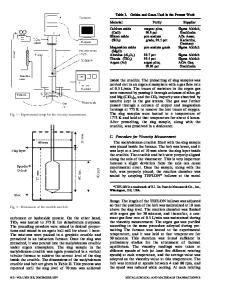Liquid Infiltration of MgO and Al 2 O 3 Thin Films
- PDF / 3,341,272 Bytes
- 6 Pages / 414.72 x 648 pts Page_size
- 43 Downloads / 297 Views
grinding, polishing, dimpling and argon ion-milling. The disks were dimpled on one-side only, and then ion-milled on the dimpled side using a specimen post for single-sided ion-milling. This preserved a flat side for film deposition that was not subjected to ion bombardment. The alumina TEM foils were then cleaned in solvents and acids to remove metallic deposits and annealed in air at 1400'C to recrystallize surface amorphization; metallic deposits and amorphous surface layers are known artifacts of the ion-milling process. 6 A pulsed-laser-ablation system was used to deposit an anorthite-glass film on the flat side of the specimen. A bulk piece of anorthite-glass served as the source material for the film, and deposition was achieved under an ambient oxygen pressure of 10 mTorr while maintaining the TEM specimen at a nominal 200'C. After deposition, the specimen was examined in a TEM operating at 300 keV equipped with an energy-dispersive X-ray microanalyzer. After characterization of several regions on the specimen, infiltration of the grain boundaries was induced by heating the foil to 16000 C in air for 20 minutes. The specimen was then re-examined in the microscope, and evidence of boundary penetration was recorded. The infiltration process was repeated with the specimen through another film deposition/penetration sequence performed in the same manner. Magnesium Oxide Electron-transparent disks of a polycrystalline zirconia-toughened magnesium oxide were prepared in a manner sinmilar to that described above. A cleaning and annealing procedure appropriate for MgO was used to remove ion-milling artifacts.7 A sintered, polycrystalline disk prepared from stoichiometric mixtures of CaCO3, MgO, and Si0 2 powders was used as the source for the laser-deposited monticellite-glass films. Similar examination/infiltration sequences were employed, utilizing temperatures ranging from 1100 to 1700'C in attempts to induce boundary penetration. Changes in film morphology during these post-deposition heat treatments prevented infiltration and these effects will be discussed. RESULTS AND DISCUSSION Aluminum Oxide Heat treatment of a pre-thinned alumina specimen after deposition of an anorthite-glass film successfully mimicked the behavior observed in bulk penetration experiments. The grain boundaries and triple junctions of the starting material were confirmed to be initially free of any amorphous material, and an example of the microstructure is shown in Figure 1. The grain boundaries in this sample are generally straight and do not display the fine-scale faceting typical of liquid-phase-sintered micr)structures. Several equilibrium triple junctions, i.e., where two-grain junctions meet at 120° angles, can be seen in the image. After deposition of a glass film and infiltration of the specimen, many of these triple junctions were found to contain a glassy phase that also appeared to penetrate the adjoining two-grain junctions, as shown in Figure 2. Complete penetration of the boundaries adjoining a triple junction was not alway
Data Loading...











